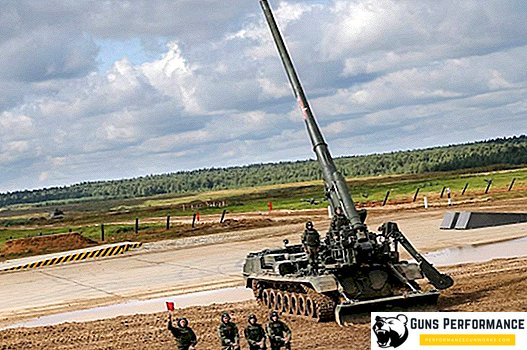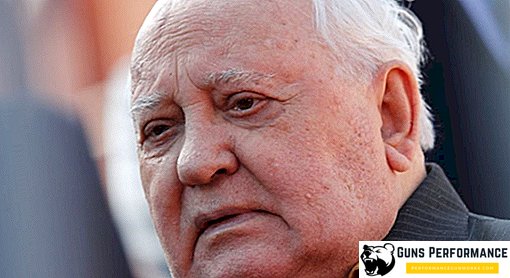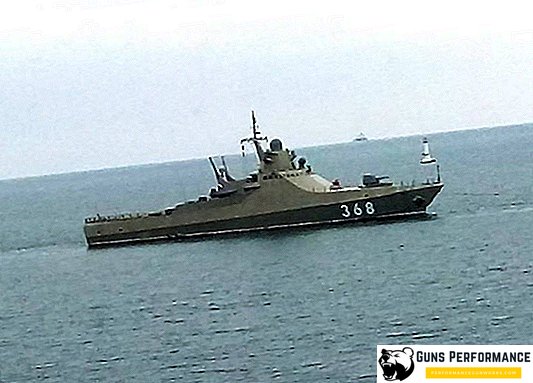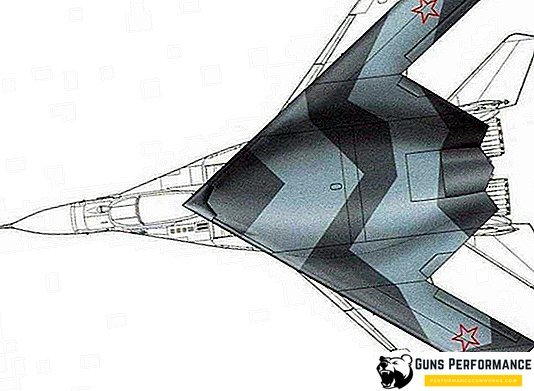Despite the development of aviation and the emergence of more and more advanced guided munitions, which are being worked on in many countries of the world, the value of barreled and rocket artillery does not become less. Moreover, the experience of local conflicts of recent decades shows the high efficiency of using multiple launch rocket systems (MLRS). More and more countries are seeking to acquire their own samples of such weapons. One of the most powerful systems of salvo fire today is the MLRS Smerch, developed in the USSR.

The Smerch can send rockets of 300 mm caliber to a distance of 90 km and combines the firepower of the legendary Katyusha and the range of destruction of tactical missiles. In one gulp, the installation covers an area of almost 70 hectares.
MLRS "Smerch" refers to the third generation of volley fire systems. The unit was put into service in 1987, currently it is in service in the Russian army, and it is also used by fifteen more armed forces.
One of the main disadvantages of the MLRS "Smerch" is its high cost. One rocket costs 2 million rubles (for 2005), the price of the complex is $ 22 million.

History of creation
The well-known BM-13 Katyusha and a number of post-war machines (BM-20, BM-24, BM-14-16), which were developed taking into account the experience of the recent war, belong to the first generation of Soviet rocket launcher systems. All of the above samples had one significant drawback - low firing range, that is, they, in fact, were the battlefield machines. This fact is absolutely not satisfied with the military, so the development in this direction did not stop.
In 1963, the world's first MLRS of the second generation was adopted - the famous BM-21 Grad fighting vehicle, which is still used today by the Russian and many other armies in the world. To say that the BM-21 turned out well - it means not saying anything. In terms of simplicity, efficiency and manufacturability, this MLRS also has no analogues today.

However, the Soviet military wanted a more powerful system that could destroy targets at significant distances.
Back in the late 60s, the designers of GNPP Splav (Tulgosniitochmash) began work on the creation of a 300 mm MRLS, which could hit the enemy at a distance of up to 70 km. In 1976, the USSR Council of Ministers decision to start work on the creation of the Smerch multiple rocket launcher appeared. About 20 USSR enterprises took part in this project.
The biggest problem when creating the MLRS long-range is a significant expansion of rockets. When the Americans were working on the creation of their MLRS MLRS, they came to the conclusion that there was no point in making an installation with a firing range of more than 40 kilometers, because it simply would not be able to hit its targets.

It should be noted that in the United States paid little attention to the development of multiple launch rocket systems, considering them exclusively weapons of the battlefield, which should directly support their troops in attack or defense. "Tornado" in its characteristics closer to the tactical missile systems and a volley of six installations is fully capable of stopping a division or destroying a small settlement. We can safely say that the MLRS Smerch is the most destructive weapon of the ground forces, not counting nuclear weapons. Sometimes the power of this complex is called redundant.
Soviet designers solved the problem of missile dispersal: they made corrected ammunition for Smerch. This solution has increased the accuracy of the complex by 2-3 times.
That missiles are the main "highlight" "Tornado". Each rocket has a control system that guides its flight in its active trajectory.

MLRS "Smerch" was adopted in 1987. During operation, the machine has been upgraded several times, which significantly improved its tactical and technical characteristics (TTH). Until 1990 (this year the Chinese MLRS WS-1 appeared), the Smerch was the most powerful combat vehicle of this class. Today it remains the most long-range salvo fire system in the world.
In 1989, a modification of the MLRS Smerch with a 9A52-2 combat vehicle and a new transport-loading vehicle appeared.
Since 1993, the MLRS "Smerch" is actively promoted in the global arms market and it must be said that there is always an increased interest in this technology. These complexes are in service with many countries, including China and India.

Description
The Smerch rocket launcher system is designed to destroy virtually any group targets at distances from 20 to 90 km. It can be armored and unarmored equipment of the enemy, his living force, communications centers, batteries of tactical missiles, command posts, enemy airfield surges. The range of destruction of the target allows you to fire from such distances that make the "Tornado" invulnerable to the enemy artillery.
The deviation of the rocket is only 0.21% of its flight range, which gives an error of 150 meters at a distance of 70 km. This is a very high accuracy for such weapons, it is achieved due to the high speed of the rocket in flight, as well as its control system.

MLRS consists of the following elements:
- combat vehicles;
- 300 mm rocket projectiles;
- transport-loading machine;
- radio-directional meteorological complex;
- vehicle for topographic shooting;
- set of special equipment.
A combat vehicle consists of a high-traffic vehicle: “MAZ-79111”, “MAZ-543M”, Tatra 816 (India) and an artillery component that is located at the rear of the vehicle. Ahead is the driver's cabin, the engine compartment and the crew cabin, it contains a fire control system and communications equipment.

The loading machine is equipped with crane equipment, it is capable of carrying 12 missiles.
The artillery unit consists of twelve tubular guides, a rotating base, lifting and turning mechanisms, as well as sighting and electrical equipment.
Each of the tubular guides is equipped with a U-shaped groove, which is needed to impart rotational motion to a missile projectile. The lifting and turning mechanism provides a tip in a vertical plane from 0 to 55 ° and a horizontal sector of pickup in 60 ° (30 ° each to the right and left of the longitudinal axis of the combat vehicle).

The fighting machine is equipped with hydraulic stops, on which the rear part of the vehicle is hung during firing. This increases its accuracy.
Both the launcher and the charging machine are almost identical. They installed a twelve-cylinder diesel engine with a capacity of 525 liters. with. The wheel formula - 8 × 8, turning are the first two pairs of wheels. On the highway, these cars can move at a speed of 60 km / h, they have high traffic and can use any kind of roads, overcome fords with a depth of one meter. Power reserve is 850 km.

Missiles MLRS "Smerch" made by the classical aerodynamic scheme with a detachable warhead. This design solution significantly reduces the visibility of the rocket on radar screens, which makes them even more deadly.
Each rocket projectile is equipped with an inertial control system that corrects its flight along the yaw and pitch in the active part of the trajectory. Correction is carried out using gas-dynamic control surfaces located in the front of the rocket. A gas generator is installed on the rocket to ensure their operation. In addition, the stabilization of the rocket is due to its rotation, as well as stabilizers, which unfold immediately after the shot and are located at an angle to the longitudinal axis of the missile.

The rocket engine is solid, it works on mixed fuel. The head part can be monoblock or with split parts. The fire can be fought as a single shot, and in one gulp. Each rocket has a length of 7.5 meters and a weight of 800 kg, of which 280 kg falls on the head.
The head part can contain up to 72 combat elements, which, due to a special mechanism, hit targets at an angle of 90 °, which significantly increases their effectiveness.
The Smerch rocket launcher produces one volley in 38 seconds. The launch is made from the cockpit or using the remote control. Preparation for the salvo after receiving the coordinates of the target takes three minutes. After a minute, the installation can leave the combat position, which makes it even less vulnerable to enemy response fire.
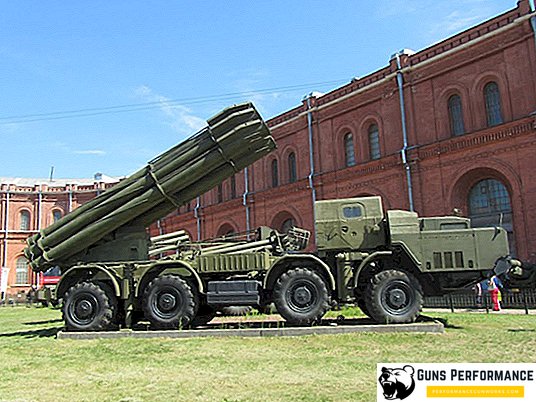
The process of loading the complex is extremely mechanized and takes about twenty minutes.
"Tornado" can use a variety of ammunition: high-explosive, cluster, thermobaric. The MLRS is capable of conducting remote mining of the territory with both anti-personnel mines and anti-tank mines. There is an experienced munition with the Tipchak reconnaissance unmanned aerial vehicle, which scans the terrain and transmits information over a distance of 70 km.
For this complex developed ammunition with a range of 70 and 90 km. A few years ago, information appeared about the creation of a new high-explosive fragmentation ammunition with a flight range of 120 km and a head mass of 150 kg.

Modernization of the MLRS (the creation of combat vehicles 9A52-2) consisted in the installation of more advanced fire control and communications equipment. This made it possible to ensure a high speed of receiving and transmitting data, protecting it from unauthorized access and more convenient display of information for crew members. Also, this equipment binds the combat vehicle to the terrain, calculates firing settings and a flight mission.
The automated Vivarium LMS unites several command and staff vehicles, which are available to the brigade commander, her chief of staff, and divisional commanders. In each of these machines installed computing equipment, communications and data encryption. Such staff vehicles can collect information, process it, and exchange data with other controls for planning and carrying out combat missions.

Another modification of this complex can be called MLRS "Kama", which was demonstrated to the general public in 2007. "Kama" has only six guides for 300-mm rockets, which are installed on a four-axle KamAZ truck. The combat and charging vehicle of the MLRS "Kama" were demonstrated in 2009.
The main purpose of the creation of "Kama" experts called increasing the mobility of the complex by reducing its size and weight. There are also opinions that the new MLRS have quite good commercial prospects.
At present, the specialists of Splava are working to create the next generation volley fire system, the Tornado. Information about its characteristics is very small, but it is likely that this MLRS will be even closer to tactical missile systems in accuracy. Most likely, the MLRS "Tornado" will become two-caliber, that is, it will be able to solve tasks that are currently performed by the "Hurricane" and "Smerch". Automation of shooting "Tornado" will reach such a level that combat vehicles can leave the position even before the missiles hit the target.

Combat use
MLRS "Smerch" was used in several local conflicts and showed its high efficiency. Russian troops used it in the first and second Chechen campaigns, this complex is used in Syria, Ukrainian troops actively used the "Smerch" in the fighting in the east of the country.

Specifications
| Fighting vehicle 9A52-2 | |
| Chassis | MAZ-543M (8x8) |
| Length mm | 12370 |
| Width, mm | 3050 |
| Mass, t | 43,7 |
| Number of launch tubes | 12 |
| Time to prepare for shooting, min | 1,5-3 |
| Time of leaving a fighting position, min | 1 |
| Reload time, min | 16-20 |
| Volley time, with | 38 |
| Calculation of the combat vehicle, pers. | 4 |
| Calculation, pers. | 2 |


